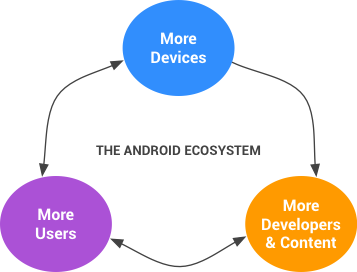الجهاز المتوافق مع Android هو أي جهاز يمكنه تشغيل أي تطبيق تابع لجهة خارجية كتبه مطوّرون تابعون لجهات خارجية باستخدام حزمة تطوير البرامج (SDK) ومجموعة تطوير البرامج (NDK) من Android. يجب أن يلتزم الجهاز المتوافق مع Android بمتطلبات مستند تعريف التوافق (CDD) وأن يجتاز مجموعة اختبارات التوافق (CTS). تكون الأجهزة المتوافقة مع Android مؤهَّلة للمشاركة في منظومة Android المتكاملة التي تتضمّن ترخيصًا محتملًا لتطبيق "متجر Google Play" ومجموعة التطبيقات التي تقدّمها "خدمات Google للأجهزة الجوّالة" (GMS)، واستخدام علامة Android التجارية. يمكن لأي مستخدم استخدام ملف رمز المصدر في Android، ولكن لكي يُعتبر جزءًا من منظومة Android المتكاملة، يجب أن يكون جهازك متوافقًا مع Android.
يوفّر هذا المستند نظرة عامة على برنامج التوافق مع Android، وهو يمثّل العمليات والمتطلبات والاختبارات المستخدَمة لضمان توافق جهازك مع Android.
أسباب إنشاء تطبيقات متوافقة مع أجهزة Android
يريد المستخدمون أجهزة قابلة للتخصيص

الشكل 1: تزدهر المنظومة المتكاملة لنظام التشغيل Android مع توافق الأجهزة
الهاتف الجوّال هو بوابة شخصية للغاية ومستمرة ومتاحة دائمًا للوصول إلى الإنترنت. لم نقابل حتى الآن مستخدمًا لا يريد تخصيصه من خلال توسيع وظائفه. لهذا السبب، تم تصميم Android كمنصة فعّالة لتشغيل التطبيقات التي يتم شراؤها بعد البيع.
يفوق عدد المطوّرين عددنا جميعًا.
لا يمكن لأيّ من مصنعي الأجهزة كتابة كلّ البرامج التي قد يحتاجها المستخدم. نحتاج إلى مطوّرين خارجيين لكتابة التطبيقات التي يريدها المستخدمون، لذا يهدف "مشروع Android Open Source Project (AOSP)" إلى تسهيل تطوير التطبيقات وجعلها مفتوحة قدر الإمكان.
يحتاج الجميع إلى منظومة متكاملة مشتركة
كل سطر تعليمات برمجية يكتبها المطوّرون لحلّ مشكلة خطأ هو سطر تعليمات برمجية لم يُضِف ميزة جديدة. وكلما زاد عدد الأجهزة الجوّالة المتوافقة، زاد عدد التطبيقات التي سنحتاج إلى تشغيلها على تلك الأجهزة. من خلال إنشاء جهاز Android متوافق تمامًا، يمكنك الاستفادة من المجموعة الكبيرة من التطبيقات المكتوبة لنظام Android مع زيادة الحافز للمطوّرين لإنشاء المزيد من التطبيقات.
أهداف البرنامج
يعمل برنامج التوافق مع Android على خدمة منتدى Android بالكامل، بما في ذلك المستخدمين والمطوّرين وصنّاع الأجهزة.
تعتمد كل مجموعة على المجموعات الأخرى. يريد المستخدمون مجموعة كبيرة من الأجهزة والتطبيقات الرائعة، ويوفّر المطوّرون هذه التطبيقات الرائعة لجذب مستخدمين جدد في أسواق كبيرة تتعلّق بتطبيقاتهم، ويكون لدى المستخدمين العديد من الأجهزة التي يمكنهم تثبيت هذه التطبيقات عليها. وتعتمد الشركات المصنّعة للأجهزة بدورها على مجموعة كبيرة من التطبيقات الرائعة لزيادة قيمة منتجاتها في نظر المستهلكين.
تم تصميم أهدافنا بحيث تعود بالفائدة على كلّ من المجموعات التالية:
-
توفير بيئة متّسقة للتطبيقات والأجهزة لمطوّري التطبيقات: في حال عدم توفّر معيار توافق قوي، يمكن أن تختلف الأجهزة اختلافًا كبيرًا لدرجة أنّه على المطوّرين تصميم إصدارات مختلفة من تطبيقاتهم لأجهزة مختلفة. يقدّم برنامج التوافق تعريفًا دقيقًا للميزات التي يمكن أن يتوقعها المطوّرون من جهاز متوافق من حيث واجهات برمجة التطبيقات والإمكانات. يمكن للمطوّرين استخدام هذه المعلومات لاتّخاذ قرارات جيدة بشأن التصميم، والتأكّد من أنّ تطبيقاتهم ستُشغّل بشكل جيد على أي جهاز متوافق.
-
إتاحة تجربة متّسقة للتطبيق للمستهلكين: إذا كان التطبيق يعمل بشكل جيد على جهاز Android متوافق، من المفترض أن يعمل بشكل جيد على أي جهاز آخر متوافق مع إصدار نظام التشغيل Android نفسه. تختلف أجهزة Android في إمكانات الأجهزة والبرامج، لذا يقدّم برنامج التوافق أيضًا الأدوات اللازمة لأنظمة التوزيع مثل Google Play لتنفيذ الفلترة المناسبة. ويعني ذلك أنّه لن تظهر للمستخدمين سوى التطبيقات التي يمكنهم تشغيلها.
-
السماح لشركات تصنيع الأجهزة بالتمييز مع الحفاظ على التوافق يركز برنامج التوافق مع Android على جوانب Android ذات الصلة بتشغيل التطبيقات التابعة لجهات خارجية، ما يمنح مصنعي الأجهزة المرونة في إنشاء أجهزة فريدة متوافقة مع النظام.
-
تقليل التكاليف والنفقات العامة المرتبطة بالتوافق يجب أن يكون ضمان التوافق سهلًا وغير مكلف لشركات المصنّعة للأجهزة. أداة الاختبار مجانية ومفتوحة المصدر ويمكن تنزيلها. تم تصميمه ليتم استخدامه للاختبار الذاتي المستمر أثناء عملية تطوير الجهاز لتجنُّب تكلفة تغيير سير العمل أو إرسال جهازك إلى جهة خارجية لاختباره. في الوقت الحالي، ليس هناك اعتمادات مطلوبة، وبالتالي لا تُفرض أي تكاليف ورسوم مقابل ذلك.
إنشاء جهاز متوافق مع Android
لإنشاء جهاز جوّال متوافق مع Android، اتّبِع الخطوات التالية:
- باستخدام AOSP، يمكنك تثبيت نظام التشغيل Android على جهازك.
- تأكَّد من امتثال جهازك لمواد مستند تعريف معايير التوافق مع Android. يحدِّد CDD متطلبات البرامج والأجهزة لجهاز متوافق مع Android.
- اجتياز مجموعة أدوات اختبار التوافق (CTS) استخدِم CTS كمساعدة مستمرة لتقييم التوافق أثناء عملية التطوير.
بعد تحقيق التوافق، يصبح جهازك متوافقًا مع Android ويمكنك التفكير في ترخيص "خدمات Google للأجهزة الجوّالة" (GMS) والاستعداد لاستخدام علامة Android التجارية. للاطّلاع على إرشادات العلامة التجارية، يُرجى الرجوع إلى قسم Android في مركز التسويق التعاوني بين الشركاء.

